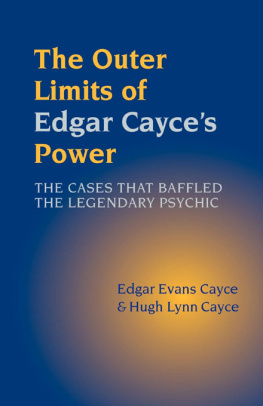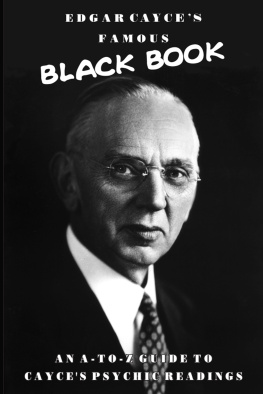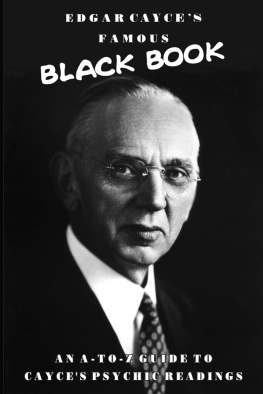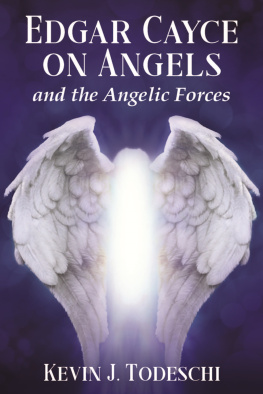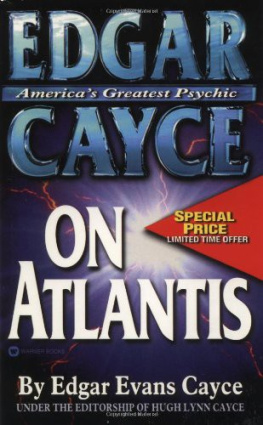Edgar Cayce
on
Angels
Also by Robert J. Grant
Love and Roses from David
The Place We Call Home
Universe of Worlds

The Empyrean
by Gustave Dor
Edgar Cayce
on
Angels
Archangels
and the
Unseen Forces
ROBERT J. GRANT
with a Foreword by G. Scott Sparrow, Ed.D.

Copyright 1994
by Robert J. Grant
17th Printing, February 2012
(Previously titled Are We Listening to the Angels?)
Printed in the U.S.A.
All rights reserved. No part of this book may be reproduced or transmitted in any form or by any means, electronic or mechanical, including photocopying, recording, or by any information storage and retrieval system, without permission in writing from the publisher.
A.R.E. Press
215 67th Street
Virginia Beach, VA 23451-2061
Library of Congress Cataloging-in-Publication Data Grant, Robert J., 1961
Are we listening to the angels? : the next step in understanding angels in our lives / by Robert J. Grant with a foreword by G. Scott Sparrow.
p. cm.
Includes bibliographical references.
ISBN 13: 978-0-87604-513-8
ISBN 0-87604-513-1
1. Angels. 2. Spiritual life. I. Title.
BL477.G73 1994
Edgar Cayce Readings 1971, 1993-2007
by the Edgar Cayce Foundation.
All rights reserved.
Cover design by Richard Boyle
This book is dedicated
with love to my father and mother,
George H. and Mary Lou Grant
Table of Contents
G. Scott Sparrow, Ed.D.
List of Plates
The plates included in this book are details by Gustave Dor and were selected from among his illustrations for John Miltons Paradise Lost, Dantes Divine Comedy, and the Bible.
Foreword
In the West we have come to depend on scientific evidence to support our theories about the world and the mysteries that still confound us. Given this hard-nosed empirical orientation, it is remarkable to me that so many people still believe in God today when God seems so unavailable to us. How is this faith sustained? When we scratch the surface of such faith, we usually discover that believers have surprisingly rich and varied experiential evidence of Gods presence in their lives. Typically, they have had dreams, visions, and inexplicable happenings that form a personal foundation for their faith in the Unseen.
Such experiences have not always been favorably considered by organized religion. Since the Reformation, Protestants in particular have looked suspiciously on anything, however sublime, that stands between an individual and his or her God. When the priestly hierarchy was swept aside by Martin Luthers effort to remove the then-perceived human barriers between ourselves and God, the spiritual hierarchy of angels and saints was deposed as well. Protestants were left trying to relate to God across a distance that was suddenly devoid of both human and divine mediators.
Not surprisingly, this condition could not last. For, whenever legitimate spiritual yearnings are suppressedor thought to be unimportant or unrealthey eventually resurface in the private experiences of individuals everywhere. Today, in books like Are We Listening to the Angels? by Robert J. Grant, we see this happening in a dramatic way. Apparitions of Mary, encounters with Christ, and the manifestation of angels combine to form a compelling case that God reaches out to us across the barren divide.
I have written elsewhere about the modern-day encounters with Christ (I Am with You Always, to be published by Bantam Books in 1995). Consequently, I have often wondered about the relationship between angels and Christ, not so much from a theological standpoint, but from a psychological perspectivethat is, from the standpoint of human need. I have asked, Why do people need angels, and how does this need differ from their need for a more human Master or Redeemer?
What occurs to me is that angels have always been the personal, albeit nonhuman, voice of God. They are, essentially, emanations from the highest Reality that, nonetheless, stop short of becoming fully incarnate. Compared to human teachers and ministers, they remain forever pristine and unsullied by ordinary life. Angels give God a kind of rarefied dimensionality, like facets of a gem reflecting and revealing its intrinsic beauty. They are like colorful rays of the one Light, providing a particular hue to what is, in itself, all-encompassing and nonspecific. It occurs to me that we need this dimensionality in order to devise a plan for living. For, it is rarely satisfying enough to contemplate a nebulous wholeness when we are struggling with very definite issues down here.
Angels make a lot of sense psychologically because they bring the Divine closer to the human realm. But if angels have to do with Gods emanations, then Christ has to do with Gods incarnationa step further in the process of God being expressed in personal form.
Drawing from several sources, Robert J. Grant makes a case that one angel in particular, the archangel Michael, was involved in helping to steward Christs incarnation. Further, Michael seems to be active in our affairs as new developments are getting ready to unfold. One gets the sense that this angel oversees Gods manifestations to the world. He is, one might say, the angel of incarnation.
Non-Christian readers may be interested to know that this relationship among God, angels, and the incarnation of God is depicted similarly in other religions. In Mahayana Buddhism, for instance, the universe is represented by the sacred mandalaa circular design which describes the relationship of the Divine to the phenomenal world. In the center of the mandala, the primordial Buddha, Vairocana, resides. Represented by white light, Vairocana is much like our transcendent deity who contains everything, but lacks specificity. Around him, however, are four dyani Buddhas who, like angels, have never been incarnate. Each of them expresses a particular attribute of the divine oneness, such as all-discerning wisdom or the wisdom of equality. One dyani Buddha, in particular Amoghasiddhi, represents all-accomplishing wisdomthe impulse to bring the Divine into material expression. Like Michael, this Buddha stands apart from the rest, somewhat, for he oversees the process of incarnation.
The importance of this angelic being to Mahayana is not surprising. For, in contrast to other forms of Buddhism, Mahayana Buddhism emphasizes that the highest achievement for any soul is to return to earth as an enlightened beingthat is, to incarnate in order to enlighten the world. So it is not surprising that Mahayanists engage in the practice of moving Vairocana from the center of the mandala to the periphery and placing Amoghasiddhi in the center instead. By meditating on this new configuration, the meditator affirms the importance of incarnation over emancipationa life of service even above the freedom that could be enjoyed by overcoming the cycle of rebirth.
Thus we can commune with angels, dyani Buddhas, and other archetypal beings who express Gods dimensionality. And we can also commune with that angelic force whose impulse is to bring God down to live among us as a complete expression of the infinite in the finite.
Next page



